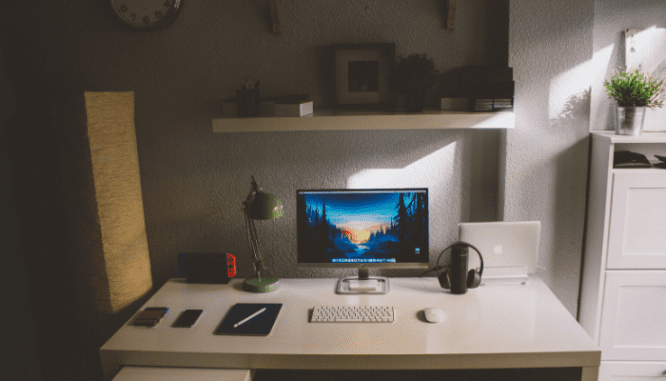How Top Agents Are Leaning Into Virtual Tours as Showings Get Complicated
- Published on
- 5 min read
-
 Astrid Storey Contributing AuthorClose
Astrid Storey Contributing AuthorClose Astrid Storey Contributing Author
Astrid Storey Contributing AuthorAstrid Storey is originally from Panama and spent most of her early years traveling through Central and South America. She arrived in Denver in 2003, the day after graduating college. During the next decade-and-a-half, she’s juggled a career in a variety of creative and marketing roles while building her own studio, Storey Creative, with clients in real estate, health care, publishing, and tech.
Virtual tours in real estate are nothing new. For at least a decade, some form of the technology has existed to help agents break away from the usual static photos, improve SEO results, drive traffic to a listing, and cater to long-distance buyers.
However, the situation surrounding the coronavirus immediately ushered virtual and video tours into the spotlight as essential tools for buying and selling homes. If you’re not using them to market your listings or help buyers shop online, then you’re already behind the eight ball.
Even when the worst of the pandemic is over, people are going to act cautiously and seek ways to avoid contact with others. Invest in mastering your virtual tour approach now, and it’ll benefit you now and for a long time to come.

The year of the virtual tour
The general goal of virtual tours under normal circumstances is to offer buyers a more immersive experience of a property online than can be delivered through photos alone — and to entice buyers to book a showing.
Now, however, virtual tours are serving a bit of a different purpose: to drastically reduce (and in a perfect world, eliminate) the amount of physical showings a seller has to accommodate. With a cyber tour, buyers can get a better feel for the property as a whole rather than having to piece together individual snapshots in their mind. A virtual tour offers context as to the home’s layout, which rooms are on which floors, and where rooms are in relation to each other.
Whereas a potential buyer might have breezed through the virtual tour or skipped it entirely before booking a showing in a pre-coronavirus world, now they should be spending a lot of time getting familiar with the property online. And listing agents should be facilitating that practice with the best virtual tours they can possibly create.
What’s in your virtual tour toolbox?
If you haven’t started implementing virtual tours before the coronavirus pandemic, the first step to getting creative is getting started. Learn your existing capabilities and take stock of your equipment. What can your phone do? Do you have a DSLR camera? Can it record video? Then, fill in your knowledge gaps. Online tutorials that teach you the basics are plentiful and easy to follow.
Various virtual tour techniques may fulfill a different set of needs for buyers and can very well co-exist or complement each other:
- Self-navigated 3-D tours are fully interactive and allow a buyer to tour the home in the order they prefer and to spend as much time as they want in a space within the virtual structure.
- A video walkthrough has a predetermined path (orchestrated by the person behind the camera). Video walkthroughs are pre-recorded and can be subsequently attached to a listing.
- A showing by proxy is when an agent is showing the house live and is able to interact with buyers and answer questions or re-visit rooms as needed.
To compile some of the best tools out there agents can use to create virtual tours on behalf of their clients, we spoke with Craig Rowe, a veteran real estate technology reviewer, and consulted the National Association of Realtors’ list of recommended virtual tour platforms. Here are a few industry standards:
| Tool/App | Pricing | Description | 3-D Self Navigable Tours? | Video Walkthroughs? | Floor Plans? |
|---|---|---|---|---|---|
| RICOH Tours | Starts at $399 + $49/month for mobile app access | Kit features a mobile app and a camera (Theta V 360) to capture room images in 4k quality | Yes | Yes | Yes |
| Immoviewer | $499/year for the standard plan plus you need to purchase a separate 360 camera from a list of recommended models | Includes a mobile app and a 360-degree camera | Yes | Yes | Yes |
| Matterport | $69/month for the professional plan; Matterport Pro 2 camera starts at $3,395. | Special 3-D capture cameras create ‘digital twin’ of a space | Yes | Yes | Yes |
| BoxBrownie | Services start at $4.00 per image for 360 enhancement or $32.00 per image for virtual staging. Doesn’t include camera equipment. | Enhancement and retouching of your existing 360-degree images, listing photos or virtual tours | Yes | Yes | No |
| Asteroom | $19.99 for monthly subscription | Smartphone virtual tours and virtual staging | Yes | Yes | Yes |
| Cupix | $24 a month per workspace. Doesn’t include camera equipment. | 3-D tours made with a consumer grade 360-degree camera or a high-end DSLR camera | Yes | Yes | Yes |
| EyeSpy360 | $34.99 per month | Create 3-D tours using any 360-degree camera or invite people to an instant, shared virtual tour | Yes | Yes | Yes |
In addition, a couple of smartphone apps capable of creating video walkthroughs include:
- Spark Camera, which lets you create video tours on your phone with no additional tools, going as far as to let you add music or voiceover narration to your finished masterpiece and share it to any social network or website platform.
- Filmic Pro, which allows you to capture, edit and produce video tours on your phone.
Tom Hall, a top-selling agent in Oklahoma City, says his preferred company is Matterport. He’s been using Matterport’s platform and camera for the last 2 years, and he feels the competitive advantage the technology provides keeps him in the forefront of his clients’ needs. (Matterport is also in the midst of rolling out a Smartphone Capture app for ease of use).
As for additional virtual tour tools for your toolbox? Todd Ruckle, a top real estate agent from Delaware, recommends a tripod, a steady hand and some practice to capture the perfect video walkthrough. “You have to lock your elbow and move with your entire body, otherwise you’re going to make the audience sick,” he says.
If you decide to hire someone for the job, Hall says you can hire a real estate videographer to build a tour for you for around $300 in his market.

Special considerations for capturing virtual tours during coronavirus
Here are some additional tips on how agents are adapting their virtual tours during the coronavirus:
Bolster your virtual tour with specifics about the property
Don’t think of your virtual tour as strictly a marketing ploy. Think of it as you would a real showing. Sure, sweeping cinematic views of the property are really nice and are sure to grab peoples’ attention. But don’t forget about including key information that will help buyers make a decision. The more property details you can provide, the better: room dimensions, ceiling height, materials used in the kitchen, baths, and flooring throughout — add voiceover or overlay text that speaks to these specifics.
Make sure the seller is comfortable with your plans
Your sellers will likely have questions about how to stay safe while having either you (their agent) or the virtual tour service provider come through and capture the necessary footage to create a cyber tour. Ruckle says he’s been working with a few sellers who have decided to leave their homes on the market, while not allowing people to come in the property.
“With those sellers,” Ruckle says, “I am happy to guide them through how to capture the images we need to build a video — like a slideshow instead of a real video. We use BoxBrownie to retouch those seller images and I coach them in case we need to do retakes.”
Hall is also accommodating his clients’ social distancing requests. He once met with a seller in a garage to exchange a disinfected set of keys (while remaining eight feet apart). He then went into the house to do a Matterport capture for 3 or so hours. He brought with him booties, a mask, gloves and disinfecting wipes. He asked the seller to leave all the lights on and interior doors open to minimize getting in contact with any surfaces and cleaned up after he was done.
“It’s not the easiest thing to do, but it is worth it if it means we can stay safe and also sell this house,” Hall says.
Conduct virtual showings with the right approach and technology
Agents are also taking clients through properties virtually one-on-one using tools like FaceTime or Zoom. For occupied properties, agents can coach sellers through hosting virtual private showings themselves where the buyer, the buyer’s agent, and the listing agent all attend virtually.
“There are so many free or low cost tools for an iPhone these days, we should all be taking advantage of them,” says Ruckle.
The National Association of Realtors is offering some great tips to agents with a series of videos called Pivot in Place. In an episode of the series posted March 30, 2020, Mabel Guzman, NAR’s 2020 VP of Association Affairs, shares a few best practices having conducted virtual showings for the past 5 years to serve overseas or traveling clients. In the video, she suggests:
- The right app is the app your client has access to.
FaceTime or Google Hangouts are popular, and this is really about making it easy for your client to conduct or attend the showing. Shelter-in-place regulations mean that it’s simplest for most households to use the technology and tools they have available on-hand or are already using. - Provide perspective.
It’s important to highlight room scale. Use existing furniture to indicate proportions, or make comments such as “this doorway is seven-feet tall, and look how much taller the ceilings are.” - Debrief with the buyer afterward.
Go back to your car and listen to the buyer’s concerns and questions. Ask if this is something they found useful, if they feel comfortable with what they’ve seen and how you can improve upon it.
Are virtual tours enough?
In most cases, a successful video tour or virtual experience will still be followed by an in-person showing. According to our Top Agent Insights Survey for Q1 2020, the majority of agents were reporting that less than 5% of their deals involved a sight-unseen offer prior to the pandemic. It appears that purchasing a house is still too big of a decision for the bulk of buyers to make online. “Most buyers are still not willing to go to the extent of putting an offer sight unseen, not even with coronavirus,” says Hall.
But nevertheless, agents are helping their clients adapt, maximize the use of virtual tours, and get creative in these challenging times.
Header Image Source: (Average Noodle / Unsplash)
